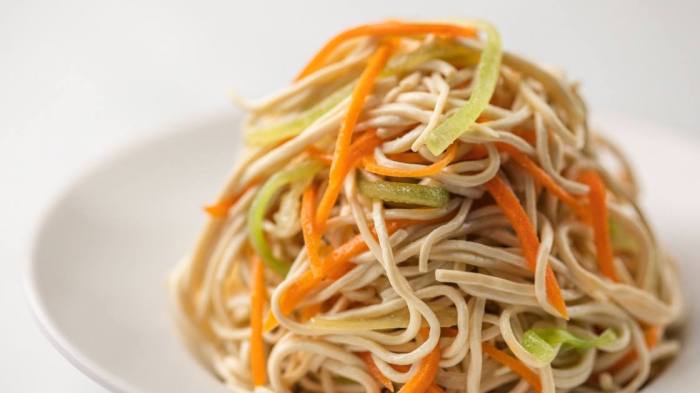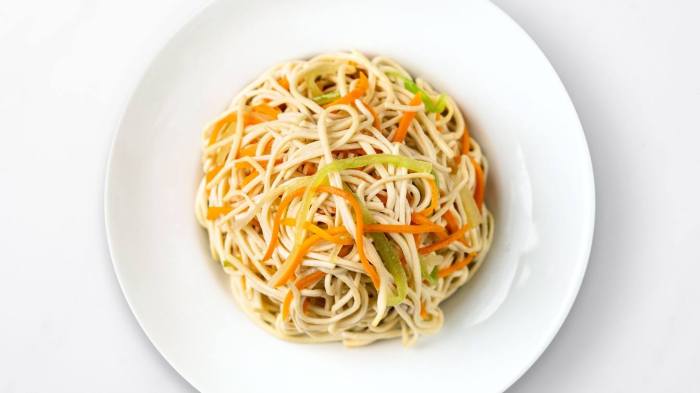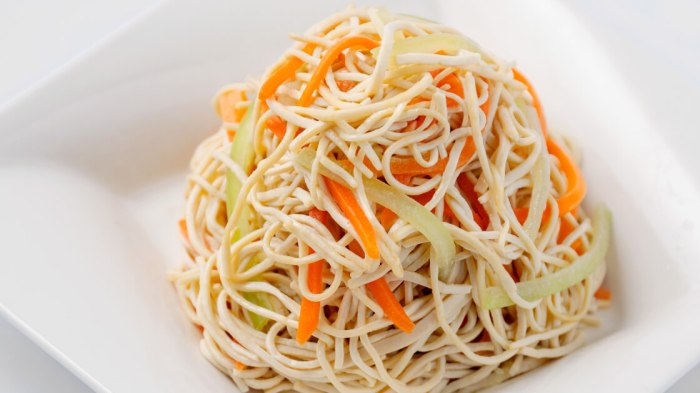Din Tai Fung Soy Noodle Salad is a captivating culinary creation that tantalizes the taste buds and transports diners to the heart of Taiwanese cuisine. This exquisite dish, with its symphony of flavors and textures, has captured the hearts of food enthusiasts worldwide.
Din Tai Fung Soy Noodle Salad boasts a rich history, dating back to the bustling streets of Taipei. Its origins lie in the street food culture of Taiwan, where vendors would serve up bowls of this flavorful salad to hungry customers.
Over time, the dish evolved and found its way into the kitchens of renowned restaurants like Din Tai Fung, where it became a signature dish.
Culinary History of Din Tai Fung Soy Noodle Salad

The Din Tai Fung Soy Noodle Salad, a staple in Taiwanese cuisine, has a rich history steeped in cultural significance. Its origins can be traced back to the 1950s in Taipei, Taiwan, where it was initially a humble street food dish.
Over time, the salad gained popularity and evolved into a refined delicacy, becoming a signature dish at Din Tai Fung, a renowned Taiwanese restaurant chain.
Regional Variations
As the salad’s popularity spread beyond Taiwan, it underwent regional variations. In Singapore, for instance, the salad is often served with a spicy chili sauce, while in Hong Kong, it is sometimes topped with roasted peanuts. These variations reflect the diverse culinary traditions of the regions where the salad has been adopted.
Ingredients and Preparation

Din Tai Fung’s Soy Noodle Salad boasts a tantalizing blend of textures and flavors, showcasing the culinary prowess of this renowned Taiwanese restaurant.
The core ingredients include:
- Noodles:Q-chewy and made with a combination of wheat flour and tapioca starch, providing a delightful bite.
- Soy Sauce:Rich, salty, and slightly sweet, the soy sauce adds umami depth and color to the salad.
- Sesame Oil:Nutty and aromatic, sesame oil enhances the salad’s overall flavor profile.
- Cucumber:Refreshing and crisp, the cucumber adds a cooling element and balances the savory flavors.
- Carrots:Sweet and crunchy, carrots add a vibrant pop of color and a touch of sweetness.
- Bean Sprouts:Crisp and slightly earthy, bean sprouts provide a textural contrast and a source of vitamins.
Step-by-Step Preparation
To prepare this delectable salad:
- Cook the noodles:Bring a large pot of salted water to a boil. Add the noodles and cook according to the package instructions.
- Drain and rinse:Once the noodles are cooked, drain them in a colander and rinse them under cold water to remove excess starch.
- Combine the ingredients:In a large bowl, combine the noodles, soy sauce, sesame oil, cucumber, carrots, and bean sprouts.
- Toss and serve:Toss the salad well to combine the flavors and serve immediately.
Nutritional Information
The following table provides the approximate nutritional information for a single serving of Din Tai Fung’s Soy Noodle Salad:
| Nutrient | Amount |
|---|---|
| Calories | 250 |
| Fat | 10g |
| Carbohydrates | 40g |
| Protein | 10g |
| Sodium | 500mg |
Sensory Experience and Flavor Profile
Din Tai Fung Soy Noodle Salad tantalizes the senses with its distinct flavor profile and textural contrast. Upon first bite, the palate is greeted by a burst of umami-rich soy sauce, complemented by the subtle sweetness of sesame oil and the refreshing acidity of vinegar.
The noodles, al dente and springy, provide a satisfying chew that balances the tender, melt-in-your-mouth texture of the cucumber and carrots.
Aroma
The salad exudes an alluring aroma that hints at its complex flavors. The fragrant sesame oil dominates the nose, followed by the subtle tang of vinegar and the earthy notes of soy sauce. As the salad is mixed, the aroma intensifies, creating an enticing olfactory experience that whets the appetite.
Flavor Profile
The flavor profile of Din Tai Fung Soy Noodle Salad is a symphony of savory, sweet, and sour notes. The umami-rich soy sauce forms the backbone of the dish, providing a deep and satisfying flavor. The sweetness of sesame oil balances the saltiness of the soy sauce, while the acidity of vinegar adds a refreshing contrast.
The subtle spiciness of chili oil adds a hint of warmth, enhancing the overall flavor experience.
| Flavor Note | Intensity |
|---|---|
| Umami | High |
| Sweet | Medium |
| Sour | Medium |
| Spicy | Low |
Texture
The salad showcases a delightful contrast of textures. The al dente noodles provide a satisfying chew, while the tender cucumber and carrots melt in the mouth. The crunchy peanuts add a contrasting textural element, enhancing the overall eating experience.
Cultural Impact and Significance

Din Tai Fung Soy Noodle Salad holds a significant place in the culinary landscape of Taiwan and beyond. It is a dish that transcends mere sustenance and has become deeply entwined with the social and cultural fabric of the region.
Role in Social Gatherings and Celebrations
The salad is a ubiquitous presence at social gatherings, family reunions, and festive occasions. Its refreshing flavors and versatility make it an ideal dish for sharing and bonding. The act of tossing the noodles together symbolizes unity and prosperity, fostering a sense of camaraderie among diners.
Reflection of Culinary Traditions and Values
The salad embodies the culinary traditions and values of Taiwan. It showcases the region’s emphasis on fresh, seasonal ingredients, skillful preparation, and harmonious flavors. The combination of chewy noodles, crisp vegetables, and savory sauce represents the balance and diversity found in Taiwanese cuisine.
Anecdotes and Stories
The cultural significance of Din Tai Fung Soy Noodle Salad is further evidenced by the countless anecdotes and stories surrounding it. One popular tale recounts a family who gathered every Sunday for a meal of the salad, sharing laughter, stories, and a deep connection to their heritage.
Variations and Adaptations
The popularity of Din Tai Fung’s Soy Noodle Salad has inspired numerous variations and adaptations, both within Taiwan and internationally. These variations have broadened the appeal of the dish and introduced new flavor profiles and culinary experiences.
Regional Adaptations
In different regions of Taiwan, the salad has undergone subtle adaptations to suit local tastes. In southern Taiwan, the salad often includes pickled mustard greens, adding a tangy and slightly spicy note. In the central region, bamboo shoots are a common addition, providing a crunchy texture and a hint of sweetness.
Creative Interpretations, Din tai fung soy noodle salad
Chefs and home cooks have also experimented with creative interpretations of the classic salad. Some popular variations include:
- Spicy Szechuan Soy Noodle Salad:This variation incorporates Szechuan peppercorns and chili oil, resulting in a fiery and aromatic salad.
- Sesame Soy Noodle Salad:Toasted sesame seeds and sesame oil add a nutty and fragrant dimension to this variation.
- Vegan Soy Noodle Salad:This adaptation replaces the pork with tofu or tempeh, creating a plant-based version of the dish.
These variations have not only expanded the culinary possibilities of Din Tai Fung’s Soy Noodle Salad but have also contributed to its enduring popularity and appeal.
Pairing and Accompaniments
Din Tai Fung’s Soy Noodle Salad is a versatile dish that pairs well with a variety of beverages, appetizers, and main courses. The following pairings enhance the overall dining experience by complementing the flavors and textures of the salad.
I’m craving the savory flavors of Din Tai Fung’s soy noodle salad right now. The clash of cultures in the dish is reminiscent of the cultures clashing on the prairie , where different traditions and customs come together to create something unique.
Just as the salad blends Taiwanese and Japanese influences, the prairie has witnessed a fascinating interplay of Native American, European, and Asian cultures.
Beverages
Refreshing beverages, such as iced tea, lemonade, or fruit juices, provide a light and refreshing contrast to the savory flavors of the salad. These beverages help cleanse the palate and enhance the subtle flavors of the noodles and vegetables.
Appetizers
Light and flavorful appetizers, such as steamed dumplings, spring rolls, or soup dumplings, serve as a perfect introduction to the meal. These appetizers provide a variety of textures and flavors that complement the salad, preparing the palate for the main course.
Main Courses
The salad can be paired with a variety of main courses, including grilled meats, seafood, or vegetarian dishes. The savory flavors of the salad balance the richness of grilled meats, while the light and refreshing textures complement the delicate flavors of seafood and vegetables.
Presentation and Plating: Din Tai Fung Soy Noodle Salad

The traditional presentation of Din Tai Fung Soy Noodle Salad is characterized by its simplicity and elegance. The salad is typically served in a small bowl or plate, with the noodles arranged in a neat mound. The noodles are topped with a generous amount of shredded cucumber, carrot, and radish, as well as a sprinkling of peanuts and crispy shallots.
The salad is often garnished with a sprig of cilantro or scallion.
In recent years, modern chefs have begun to experiment with more innovative plating techniques for Din Tai Fung Soy Noodle Salad. Some chefs have opted to arrange the noodles in a more artistic manner, creating intricate patterns or designs. Others have chosen to use more colorful ingredients, such as shredded beets or purple cabbage, to add visual appeal to the salad.
Gallery of Images
Here is a gallery of images showcasing different presentation styles for Din Tai Fung Soy Noodle Salad:
- Image 1: A traditional presentation of the salad, with the noodles arranged in a neat mound and topped with shredded cucumber, carrot, and radish.
- Image 2: A more modern presentation of the salad, with the noodles arranged in a spiral pattern and topped with shredded beets and purple cabbage.
- Image 3: A close-up of the salad, showing the intricate details of the noodle arrangement and the colorful ingredients.
Nutritional Value and Health Benefits
Din Tai Fung Soy Noodle Salad offers a nutritious balance of carbohydrates, protein, and essential vitamins and minerals. The noodles, made from wheat flour, provide complex carbohydrates for sustained energy. Soybeans, a key ingredient in the sauce, are a rich source of protein, fiber, and isoflavones, which have antioxidant and anti-inflammatory properties.
Vitamins and Minerals
The salad is a good source of vitamins, including vitamin C, vitamin A, and B vitamins. Vitamin C supports immune function and collagen production, while vitamin A promotes eye health and skin health. B vitamins play a crucial role in energy metabolism and nervous system function.Additionally,
the salad contains essential minerals such as potassium, magnesium, and calcium. Potassium helps regulate blood pressure, while magnesium supports muscle and nerve function. Calcium is vital for bone health and muscle contraction.
Antioxidants
The salad is rich in antioxidants, including isoflavones from soybeans, vitamin C, and vitamin E. Antioxidants protect cells from damage caused by free radicals, which are unstable molecules that can contribute to chronic diseases.
Question Bank
What is the origin of Din Tai Fung Soy Noodle Salad?
Din Tai Fung Soy Noodle Salad originated in the street food culture of Taiwan.
What are the key ingredients in Din Tai Fung Soy Noodle Salad?
The key ingredients include soy noodles, cucumbers, shredded chicken, and a flavorful soy-based dressing.
What is the unique texture of Din Tai Fung Soy Noodle Salad?
The salad has a combination of soft and chewy noodles, crunchy cucumbers, and tender chicken, creating a delightful textural experience.